A History of the County of Hertford: Volume 2. Originally published by Victoria County History, London, 1908.
This free content was digitised by double rekeying. All rights reserved.
'Parishes: Rickmansworth', in A History of the County of Hertford: Volume 2, (London, 1908) pp. 371-386. British History Online https://www.british-history.ac.uk/vch/herts/vol2/pp371-386 [accessed 12 April 2024]
In this section
RICKMANSWORTH
Prichemareworde (xi cent.); Rykemersworye, Rykesmaresworth, Rickmersworth (xiii cent.); Rickmersworth or Rickmansworth (xvi cent.).
Rickmansworth is a large parish on the Buckinghamshire and Middlesex border of the county, and has since 1898 been divided into three civil parishes, Rickmansworth Urban, Rickmansworth Rural, and Chorleywood. (fn. 1) There is also a detached portion of Rickmansworth Rural. The area of Rickmansworth Urban is 574 acres, that of Rickmansworth Rural 7,463 acres, and that of Chorleywood 1,986 acres. In 1846 part of the parish was formed into the district chapelry of West Hyde, (fn. 2) and parts were assigned to the chapelries of Northwood in 1854, (fn. 3) of Croxley Green in 1872, (fn. 4) and of Mill End in 1875. (fn. 5) Batchworth and Mill End are hamlets south and west of the town, and West Hyde beyond Mill End is a chapelry in Rickmansworth Rural. O'Connorville, Herringsgate or Heron's Gate is to the south-west of Chorleywood. Here Feargus O'Connor the Chartist leader bought an estate designed to be divided into small holdings, to be let to the subscribers to the 'National Land Company.' Extravagant hopes were held out to the factory hands and others who subscribed, that on this and other estates bought by the company, they would be able to live an idyllic country life.
The broad flat valley of the River Colne runs east and west through the centre of the parish of Rickmansworth. The Rivers Chess and Gade flow in from the north and are parted by a low watershed. These streams are lost in the Colne, which bends westwards on leaving the town. The Grand Junction Canal, which was made early in the nineteenth century, (fn. 6) joins the Colne for some three-quarters of a mile in the south of Rickmansworth. The town of Rickmansworth is in the centre of its parish, and is set in a network of water, formed by these curving streams and their many tributaries, which flow under bridges or cross the open road. The High Street which runs east and west is part of the Watford and Uxbridge high road. On the north side is a low one-storied brick building, consisting of five almshouses built in 1682 by John Fotherley, then lord of the manor. On the south side of the street is the manor-house of the Moor, a plain red-brick house now used as three dwellings. There is also in this street the Old Swan Inn. This inn used to have a pew in the church by prescriptive right for many years, (fn. 7) but all old pew rights fell out of use when the old church was pulled down in 1826. Many other old houses still stand in this quiet, though slowly growing, country town. At the east the High Street bends northwards, passing on the left, a little back from the road, a high red-brick house, with parapet and tiled roof, called Basing House. This was the home of William Penn, the founder of Pennsylvania, for a few years after his marriage in 1672. It is now the residence of Mr. Roderick W. Henderson, J.P. Beyond, the road curves, and crossing the Chess ascends a steep hill. At the foot of the hill and on the Chess is a large modern plaster and timber house known as Scotsbridge House, formerly the property of the late Mr. Sidney Roberts, J.P., and at the top is the church and parish of Croxley Green. A road branching from here north to Sarratt runs through Croxley Green, a long open piece of grass land edged with a few houses, and many cherry orchards. Some of the houses are old, brick and timber, and at the north end of the green is a long slated house called Croxley House, the property and residence of Mr. W. R. Woolrych, J.P. Micklefield Hall, which lies to the west, is the property of Mr. T. Meadows Clutterbuck, the lord of the manor.
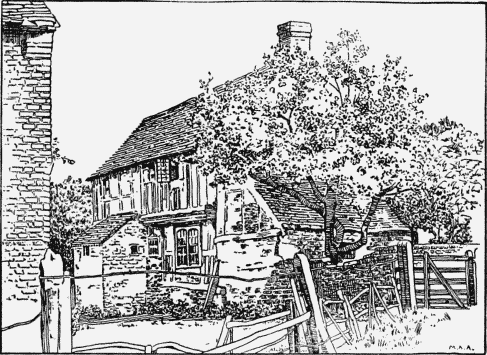
King's Farm, Rickmansworth
At the east end of Rickmansworth town, Church Street turns off abruptly from the High Street, and bending south passes near the vicarage on the right. A little farther at a bend 10 the road is the church in its churchyard, and close by, to the north-west, is The Priory, an old red-brick and tiled house, now the residence of Mrs. Allan Edward and the property of Lord Ebury. The road next leads by the terminus of a branch of the London and North Western Railway, and crossing streams and the canal passes through a little group of houses called Batchworth hamlet. It then skirts Moor Park and ascends a steep hill towards Pinner. On the top of the hill is the hamlet of Batchworth Heath, with its open common.
West of the town, the High Street follows the Colne river and is the Uxbridge high road. Meadows lie on either side and many small residences are here springing up. The road leads through the district called Money Hill, where there is a large stucco house called The Cedars, the 'Dalrymple Home' for inebriates, situated on a beautifully-wooded terrace overlooking the Colne. Beyond Money Hill is Mill End. There is a good red-brick house here called Money Hill House, the residence of the Hon. Mrs. Louis Guy Scott. In the north-west of the town a road leads to Amersham and passes through Chorleywood. The River Chess flows through this parish and forms a small part of the north-eastern boundary, but the rest of Chorleywood lies above this valley and is in one part some 300 ft. high. There are two houses of importance near the village, both standing in large parks: Chorleywood House, the residence of Lady Ela Russell, and Chorleywood Cedars, the property and home of Mr. J. Saunders Gilliat, J.P. A mill called Solesbridge used to stand on the Chess, the site of which belongs to Mr. T. M. Clutterbuck. The water there is now used to hatch trout for the Chorleywood and Colne Fisheries. Near the site of the mill is Loudwater House, a large white stone verandahed house belonging to Mr. H. W. Birch, and tenanted by Mr. John Kerr. Near it is a house called Loudwater or Glen Chess.
The Metropolitan Railway passes through the parish, and has a station close to the town. A branch of the London and North Western Railway has a terminus in the east of the town. The growth of the town is chiefly seen near these stations.
Rickmansworth became a market town by a charter of Henry VIII in 1542, whereby the bailiffs and inhabitants were licensed to hold a market on Saturdays and a fair on the feast of the Assumption. (fn. 8) A large timber-framed market-house was erected in the High Street, and was granted in 1627–8 to William earl of Pembroke. (fn. 9) It formed an obstruction to traffic, and was pulled down in 1805, when another market-house was opened nearly opposite, chiefly for the sale of corn. This building is described in 1808 as a mean fabric supported by pillars, and open beneath. (fn. 10) After the opening of the railway, local trade passed almost entirely to Watford, which is much more conveniently situated on the main line, and the market-house was disused. In 1868 it was pulled down and a town hall erected on the site. The market has long been discontinued, but two fairs were held on 20 July and 24 November, chiefly for the sale of horses, cattle, sheep, and hogs. The July fair was abolished in 1882, and the statute fair, held on the second Saturday in September for the hiring of farm servants, was abolished at the same date. (fn. 11) This fair was locally known as a 'statty,' and by the middle of the nineteenth century had quite lost its usefulness, for the greater number of the labourers who resorted thither had no intention of leaving the service they were then in, and the fair simply afforded the farm labourers a time-honoured excuse for spending their harvest-money in beer at some of the many inns and beershops, of which there were no less than forty-nine in the parish at the time when Mr. Cussans wrote his History of Hertfordshire. (fn. 12) In 1819 the town was governed by two constables and two headboroughs. (fn. 13)
In 1905 Rickmansworth included 3,216 acres of arable land, 3,024 acres of permanent grass, and 611 acres of woodland; and Chorleywood 275 acres of arable land, 543 acres of permanent grass, and 149 acres of woodland. (fn. 14) The soil is gravel, sand, and clay, producing crops of wheat, barley, oats, and turnips.
The parish, which is well-wooded, contains many beautiful parks and several commons, among which are Fortune Common and Grove Green and other small greens. Lockhill Wood Common was in–closed in 1859. (fn. 15) The Common Moor, south-west of Croxley Mills, though lying almost entirely in the parish of Watford, is an adjunct to Croxley manor, and the inhabitants of Watford have no rights with respect to it.
Watercress beds abound on the banks of all three of the rivers, and the cultivation of this plant is an important industry of the townspeople. Strawplaiting was also largely carried on in the parish. During the sixteenth and seventeenth centuries many of the principal inhabitants were described as 'clothiers,' from which it may be inferred that the manufacture of cloth was at one time carried on in the parish, but this industry has long since ceased. (fn. 16) There were also silk and flock mills here, described in 1808 as recently built. (fn. 17)
The town is lighted by gas and supplied with water from an artesian well at Batchworth belonging to the Rickmansworth and Uxbridge Valley Water Works, which were opened in 1889. The mineralwater works of Messrs. Franklin & Sons are in High Street.
Place-names which occur are Great Culvershott, Pullingspit, Scottes Bridge, Scottes Hill, Gorewellmade, Personesfeld, Cowemore, Sexteyn-lane, le Burywater, le Red Heath, Wyddemore, Philpottsmeade, Blackett, Porthors, Crowches, le Newlond, Bebirifeld, and Hawkwelleslond.
John Mitchell Kemble, the philologist and historian, lived for a short time in a small house near Rickmansworth. He was then engaged on Saxons in England, and was contemplating a History of Roman Law. His reputation as an Anglo-Saxon scholar was established in England by the publication of his edition of the poems of Beowulf in 1833. From 1835 to 1844 he was editor of the British and Foreign Review. The best-known of his works is the Codex Diplomaticus. (fn. 18)
Thomas Brugis, a surgeon of some reputation, practised at Rickmansworth. He was the author of the Marrow of Physicke, and Vade Mecum or a Companion for a Chirurgion, of which the first edition appeared in 1651. (fn. 19)
George Swinnock, the Nonconformist divine, was intruded as vicar of Rickmansworth in 1650. He was the author of several religious works, which were collected and published in 1665. (fn. 20)
Giles Lawrence, Regius Professor of Greek at Oxford, was vicar of Rickmansworth for about six months in 1580–1. He was a friend of Jewell, and assisted in his escape to the Continent in 1555.
John Clarke-Whitfield, the organist and composer, was the son of Amphillis, daughter of Henry Whitfield of the Bury. He was appointed professor of music to the University of Cambridge in 1821, and held the post till his death in 1836. He did good work in editing the scores of Purcell, Arne, and Handel.
William Prowting Roberts, a solicitor and tradeunion advocate, died at Heronsgate House, and was buried at Chorleywood church in 1871.
Sir Thomas White, the founder of St. John's College, Reading, was the son of William White, a clothier of Rickmansworth. He was born in 1492 at Reading, and was a friend of Sir Thomas Pope, founder of Trinity College, Oxford, to whose example the foundation of St. John's College is perhaps due.
MANORS
The manor of RICKMANSWORTH is said to have been granted to the abbey of St. Albans by Offa, (fn. 21) and was confirmed to the abbey and convent by King John. (fn. 22) In 1278 it was presented that Rickmansworth was ancient demesne of the crown, and had been from time immemorial, and the manor had been in the possession of the abbots of St. Albans before the Conquest of England. (fn. 23) In the twelfth century Rickmansworth supplied towards the maintenance of the abbey forty-eight hens and one pig at Christmas, and 1,000 eggs and one pig at Easter. (fn. 24) Various parcels of land in Rickmansworth were acquired for the abbey by Abbot Roger in the latter part of the thirteenth century. He bought of John de Britewelle certain land and rent in Rickmansworth and elsewhere, which formerly belonged to William son of John de Shelford. (fn. 25) Ralph Clobbe gave a yearly rent of 6d. from two tenements in Rickmansworth, and also a piece of moor there. (fn. 26) Robert le Porter gave a rent of 3s. from 11 acres of land and 2 acres of meadow, and Adam Cave gave a moor. (fn. 27) The abbot in 1284 bought of Richard son of Alfred land called 'le Newlond,' and a messuage and 4 acres of land in Bebirifeld, and a messuage and 3 acres of meadow in Rickmansworth, (fn. 28) which, two years later, were assigned to the sacrist. (fn. 29)
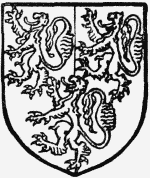
Herbert, Earl of Pembroke. Party azure and gules with three lions argent.
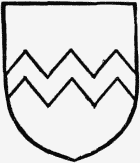
Fotherley. Gules a fesse dancetty argent.
At the time of the Dissolution the manor was in lease to John Palmer for thirty-one years, (fn. 30) and in 1550 it was granted to the bishop of London, (fn. 31) but on the accession of Mary he was dispossessed, and the manor was granted to his successor in the see. (fn. 32) His lands in turn were seized by Queen Elizabeth, who granted the site of this manor in 1572–3 to Margaret Palmer for twenty-one years, beginning at Michaelmas, 1595. (fn. 33) In 1588–9 a further lease for twenty-one years was granted to Francis Palmer. (fn. 34) In 1591 John bishop of London granted the manors of Rickmansworth and Pinchfield to Queen Elizabeth, probably in confirmation of her previous estate. (fn. 35) In 1608 the manor was occupied by Sir Francis Wolley, (fn. 36) and the site was granted in 1610 for sixty years to Sir Gilbert Wakering. (fn. 37) It was granted in the same year to Henry, Prince of Wales, and after his death to trustees for Charles, Prince of Wales, in 1616. (fn. 38) These trustees sold the manor in February, 1628, to William earl of Pembroke, and in the July following this sale was confirmed by letters patent of the king. (fn. 39) William died in 1630 without issue, and was succeeded by his brother Philip, (fn. 40) who sold the manor in 1632 to Thomas Fotherley. (fn. 41) Thomas was succeeded by his son John, who held courts for the manor from 1688 to 1698. (fn. 42) John married Dorothy daughter of Sir Ralph Whitfield, but all his children died without issue in his lifetime. (fn. 43) He died in 1702–3, and by his will left this manor to his widow Dorothy for life, with remainder to her nephew Temple Whitfield and his brother Henry, and others in tail male. (fn. 44) Temple died in 1732, and as his brother Henry had predeceased him the manor came to his nephew Henry, son of the said Henry. He died in 1747, and the manor came to his son Henry Fotherley Whitfield, who settled it upon himself and his heirs in 1753. (fn. 45)
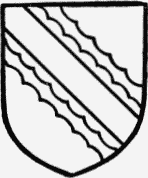
Whitfield. Argent a bend between two cotises engrailed sable.
Till this time the manor-house had been The Bury, near the church, but Henry Fotherley Whitfield built a new mansion in the Bury Park, now known as Rickmansworth Park. He appears to have been an improvident man, and sold or mortgaged large portions of the estate. (fn. 46) He died in 1813, having bequeathed that portion of the estate which he had neither sold nor mortgaged to his widow Mary. (fn. 47) In 1818 John Forster and Thomas Deacon, trustees of the will of Henry Fotherley Whitfield, conveyed the manor to Robert and William Williams and Thomas Lane, trustees of the last will of Robert Williams the elder, of Moor Park. (fn. 48) In 1829 Robert and William, the surviving trustees, sold it to John Alliston of London, who in the same year resold it to William Windale. He immediately mortgaged it, and it was sold by the mortgagee to William Dimes of London, who sold it in 1853 to his son William Piercy Dimes. (fn. 49) He sold it in 1858 to Francis Thomas Cuddon, and he in 1868 to John Saunders Gilliat, (fn. 50) of Chorleywood Cedars, the present owner. Mr. Gilliat is a member of the Court of Lieutenancy of the City of London, and a director of the Bank of England, of which he was governor from 1883–5. His residence, Chorleywood Cedars, was bought by him in 1860, and the house, which stands upon the site of a much smaller one, for many years the residence of William Longman, was built in 1865. (fn. 51) The great feature of the place is the magnificent cedars of Lebanon from which the house takes its name. They are estimated to be of about the same age as those at Cassiobury, which were planted in 1670.
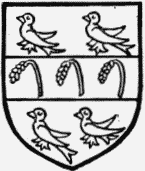
Gilliat. Or a fesse sable with three ears of wheat or thereon between four martlets sable.
The Bury is charmingly placed in the angle of a tributary of the River Colne, not far from its junction with the river. Originally the park extended over a large part of what is now the town of Rickmansworth, but the grounds are now reduced to a few acres immediately about the house and are well wooded, with a beautiful lawn on the west of the house, which faces nearly east and west, with the entrance on the east. The original plan is that of an early seventeenthcentury house, with a central block and two wings; but about the middle of the nineteenth century the north wing was pulled down. The materials are brick and half timber rough-cast, with tile roofs, and there are a few portions of rough flint walling in the foundations which may belong to a still earlier building. In the first half of the eighteenth century the house was considerably altered and redecorated, and was practically refronted to the west, while the greater part of the south wing was converted into an orangery. About the middle of the nineteenth century the place was allowed to fall out of repair, part of it being used as a coal and grain warehouse, and the north wing was pulled down, the material being used to construct a bakehouse, the chimney of which is still standing to the north of the house. In the latter half of the same century it was in some measure restored to its earlier condition. There is a considerable amount of good seventeenth-century panelling in the house, chiefly in the present drawing-room and dining-room, that in the former room having been grained to represent walnut. The dining-room has a handsome oak mantel with elaborate detail, and the fireplace has a straight-sided four-centred head with continuous mouldings. A second mantel in this room, now used as a sideboard, was removed from the room now used as the kitchen. A small square panel in the centre has on it an ostrich carved in relief. There are two staircases of about the same date as these mantels, the main one in the central wing, the other in the south wing. A large room on the west front of the central wing has been completely redecorated in the eighteenth century, and the two ends are treated with pilastered and coved recesses. Several of the bedrooms were decorated at the same time and sash windows inserted. On the east, however, the original wooden mullioned frames remain much patched with later work. There are also some good brick chimney-stacks with shafts placed angle-wise.
There is an avenue from the Bury leading towards Rickmansworth Park, the grounds of the two estates having once adjoined. The Bury now belongs to Lord Ebury, and is tenanted by Mr. T. W. Bevan.
RICKMANSWORTH PARK
RICKMANSWORTH PARK lies to the north of the town, and formerly constituted part of the demesne lands of the manor of Rickmansworth. In a deed of bargain and sale by John Fotherley and Sir Thomas Fotherley his son, in 1685, various closes are said to be impaled and formed into a park. (fn. 52) The park came with the manor to Henry Fotherley Whitfield, who built the mansion house there shortly before his death in 1813. (fn. 53) He left the estate to Mary his wife, who afterwards married Thomas Deacon. Rickmansworth Park was sold in 1831 to Mrs. Temperance Arden as trustee for the will of her husband. Under the trusts of the will the estate came to Joseph Arden, who died in 1879, when it was sold to Mr. John William Birch. (fn. 54) Rickmansworth Park is now the seat of Mrs. Birch, his widow, and daughter of Mr. J. Arden. (fn. 55)
There was a mill at Rickmansworth at the time of the Domesday Survey. (fn. 56) The water-mill, called West Mill, belonged to the abbot and convent of St. Albans, and was leased by them to Ralph Bukberd for a term of years ending in 1539. In 1533 they leased it from the end of this term for twenty-six years to Richard Wilson of Watford. He was to keep in repair the mill and also two millstones, 10 in. in thickness, and 4 ft. 8 in. in breadth. (fn. 57) The mill was leased in 1544 to William Hutchinson, yeoman of the spicery, and Janet his wife for their lives. (fn. 58) It afterwards came to John Wilson, and was granted in 1576–7 to Richard Master. (fn. 59) There was also a water-mill called Batchworth Mill, and a fishery called Blacketts Mill in Rickmansworth. (fn. 60) Batchworth Mill was later used as a cotton mill, but was bought in 1820 by Messrs. John Dickinson & Co., and converted into paper mills. (fn. 61) It is now being pulled down and the site used by the Rickmansworth and Uxbridge Valley Water Company.
A mill at Croxley was given by Richard de Croxley to the church of St. Mary, Clerkenwell. (fn. 62) There are now mills on the Gade at Croxley called Croxley Paper Mills, built in 1830, and owned by Messrs. John Dickinson & Co. (fn. 63) There was also a paper mill at Mill End on the Colne, which in 1881 belonged to Mr. George Austin, (fn. 64) and now belongs to Peter Clutterbuck, J.P. At Scots Bridge on the Chess, at Croxley Green, there is a mill, formerly a paper mill. It was sold in 1848 by Thomas Weedon to Herbert Ingram, who sold it ten years later to William McMurray. (fn. 65) It now belongs to the International Photo Printing Syndicate, Limited. Loudwater Mill also belonged to William McMurray, but has now been demolished. At the junction of the three rivers, the Colne, the Chess, and the Gade, just outside Rickmansworth, there is a corn mill. Troy Mill is on the Colne in the detached part of Rickmansworth Rural.
Like many other of the tenants of the abbey of St. Albans, at the time of Wat Tyler's rebellion the men of Rickmansworth extorted from the abbot a charter of liberties, two forms of which, both dated 1381, are given in the Gesta Abbatum. The inhabitants of Rickmansworth living within certain boundaries obtained licence to sell and alienate their land to whomsoever they would, paying to the abbot and convent an annual rent for all services and demands. All the tenants were to have free fishing in the water called 'Pichelesborne,' as was the custom, and also free common in Burymore in Batchworth, for all their animals except pigs and geese, paying to the abbot 3d. annually for each animal. In the second charter, licence to fish in the water called 'Gatesey,' and free common in Heyghmore, Hallemore, and Battesmore, with the same restrictions and for the same payment, were added to the liberties mentioned above, and the boundaries within which the tenants enjoyed these liberties are different. (fn. 66)
The first mention we find of the manor of MOOR (La More) is about 1182, when it was given by the abbot of St. Albans to Adam Agnū [Aignel], in exchange for two hides and a half in Horwood. It had formerly been held by Master Ambrose, and was from thenceforth to be held of the abbot for a rent of 10s. and foreign service due from it to the king. (fn. 67) From Adam it descended to his great great grandson John son of William Aignel, who died in 1364, holding it of the abbot and convent of St. Albans by knight service. (fn. 68)
In an inquisition taken on his death it was found that the manor was held of the king by petty serjeanty of rendering one axe, and the manor comprised a principal messuage, 40 acres of land, 18 acres of meadow, and 3 acres of pasture. On this account the king claimed the custody of John son of John Aignel, who was a child of three years. But the abbot disputed this finding, and judgement was given in his favour in 1366. (fn. 69) Katherine, wife of John Aignel, afterwards married Andrew de Bures, who sued the abbot for Katherine's dower in the manor. (fn. 70) In 1416 Katherine, wife of William Curteys, late wife of John Aignel, probably the infant son of John son of William, conveyed the manor to William Flete and others, (fn. 71) and in the same year John Impey and Joan his wife, kinswoman and heir of John Aignel, conveyed their interest in the manor to the same feoffees. (fn. 72) Under William Flete as tenant the park of Moor was inclosed in 1426, when he and his co-feoffees obtained licence to crenellate, enturret, and embattle with stone, lime and 'brik' their manor of Moor, and to impark 600 acres of land in the wood there. (fn. 73) This tenant caused the abbot trouble as to the services due for this manor and various others which he held of the abbot in Rickmansworth, by quoting the inquisition on the death of John Aignel, which had been proved to be a wrong finding. Judgement was again in 1431 given in favour of the abbot, and William was forced to do the services due and pay arrears of rent. (fn. 74) In this suit it is stated that the manor of Moor was held by the service of finding a horse for the abbot every time he rode to his cell of Tynemouth. (fn. 75) In 1456 the manor had by some means come to Sir Ralph Boteler, Lord of Sudeley, and the abbot, taking advantage of the fact that Sir Ralph was an upright man, thought that he now had a good opportunity of settling once for all the difficulty of the overlordship of this manor. He, therefore, in exchange for certain tenements in London on the Thames, confirmed the manors of Moor, Ashleys, Britwell, Batchworth, and Eastbury to Sir Ralph, quit of all services and rents, except a rent of 1d. for each manor in recognition of the fact that it was held of the abbey. (fn. 76) Shortly after this time, however, Sir Ralph lost his only son and heir, Sir Thomas Boteler, and on this account determined to sell the reversion of the manor after his death and that of his wife Elizabeth, and expend the produce on pious uses. (fn. 77) The abbot, thinking that it would save him much future trouble, determined to buy it, and with the aid of Lady Sudeley, his kinswoman, an agreement was made by which he purchased it for 3,000 marks, and the prayers of the convent for Sir Ralph, his wife and son. (fn. 78) The manor was conveyed in 1460 to trustees, John Eure, Thomas Clopton, and others, who conveyed it in the same year to the abbot and convent. (fn. 79) It was apparently afterwards sold to George Nevill, archbishop of York, brother of the 'king maker,' (fn. 80) who lived there during 1470, (fn. 81) when his brother Warwick and the duke of Clarence had been driven out of the country. He spent the Christmas of 1471 at the Moor entertaining his friend John Paston. After a visit of the archbishop to Edward IV at Windsor, the king invited himself to return the visit at the Moor. The archbishop preceded him and made great preparations, bringing out all the plate which he had hidden after Barnet and Tewkesbury. But the day before the king was to come Nevill was summoned to Windsor and put under arrest on a charge of corresponding with the exiled earl of Oxford. The king seized the manor of Moor, with goods said to have been worth £20,000, (fn. 82) and the custody of the park was granted in 1475 to John Hawdeles. (fn. 83) The manor appears to have been granted to the dean and canons of St. George's, Windsor, at about this time, (fn. 84) and they, at the desire of the king, granted it to him again in 1483. (fn. 85) In 1484 the custody of the park was granted to Edward Gower, (fn. 86) and the manor of Moor was granted in 1486 to John de Vere, earl of Oxford, and Margaret his wife and the heirs of their bodies. (fn. 87) John died without surviving issue in 1513, (fn. 88) whereupon the manor again came to the crown.
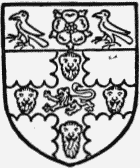
Wolsey, Cardinal. Sable a cross engrailed argent and thereon a lion passant gules between four leopards' heads azure with a chief or having a rose gules between two Cornish choughs therein.
It was immediately leased for seventy years to Thomas Ruthall, bishop of Durham, (fn. 89) and in 1515 the king granted the manor, subject to the above lease, to feoffees, Bartholomew Westby and others, in trust for Thomas abbot of St. Albans, who in return gave the king 3,000 marks and certain lands at the Steel Yard and Baynards Castle in London. (fn. 90) In November following Bartholomew Westby and his co-feoffees conveyed their interest to the abbot and convent. (fn. 91) Up to the middle of 1518 the bishop of Durham held the manor under the lease above referred to and resided there periodically, (fn. 92) but before April, 1520, Thomas Ramridge, abbot of St. Albans, must have compounded with him for the remainder of the lease, as we find the abbot was at that time in possession. (fn. 93) Wolsey was elected abbot of St. Albans between 1516 and 1521, (fn. 94) and perhaps in this capacity came into possession of the Moor, which he made one of his chief residences, and there kept great state, frequently entertaining the king and his court. He enlarged the house, and seems to have maintained the gardens at great cost. (fn. 95) It would appear that he also enlarged the park, for he expelled one of his tenants from a messuage called Tollpotts and 170 acres of land, and inclosed part of it within the park, and made another part into a highway leading from Rickmansworth to Watford. (fn. 96)
Here on 30 August, 1525, was concluded the important treaty of peace between England and France known as the Treaty of The Moor. Wolsey, Norfolk, Suffolk, Warham, the bishop of Ely, and others were present on behalf of Henry, and Brinon and John Joachim on behalf of Francis. On 6 September following, the proclamation for peace was issued from the Moor. (fn. 97) On the fall of Wolsey this manor seems to have been seized by the king, who made it one of his principal residences, (fn. 98) and sent Queen Katherine of Arragon there during the divorce proceedings against her, (fn. 99) but as in 1531 the Moor is mentioned as a house belonging to the abbey of St. Albans, (fn. 100) Henry's possession at this time was probably only permissive.
He granted the custody of the manor with 4d. a day to Sir John Russell for life in 1529. (fn. 101) Sir John was created earl of Bedford, (fn. 102) and surrendered the custody to the king in 1531, (fn. 103) when it was again granted to him and his son Francis for their lives. (fn. 104) In 1531, probably to make his claim to the manor secure, Henry VIII obtained a grant of it from Robert, abbot of St. Albans, the successor of Wolsey, in exchange for the possessions of the priory of Pray. (fn. 105)
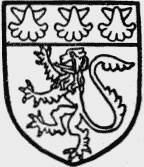
Russell. Argent a lion gules and a chief sable with three scallops argent therein.
Sir John Russell, keeper of the park, in 1533 addressed numerous complaints to Cromwell as to the dilapidated state of the park palings, for the repair of which he was allowed no supplies. He stated that those who went to the park with carriages broke down the hedges and made highways through it. The garden also was in a ruined state, and of 400 or 500 deer only 100 remained, as they broke out from the park, and were killed daily. The king allowed the gardener only 6d. a day, and at that wage no one would undertake the work. In a later letter Sir John stated that the paling of the park would be 1,500 poles, and that he had felled 200 oaks for the purpose. In Wolsey's days £40 to £50 a year had been spent upon the upkeep of the gardens alone. (fn. 106)
The Count Palatine paid a visit to Henry VIII at Moor Park in 1539. (fn. 107) In 1540 the king gave the manor of Moor to Anne of Cleves for life, as a jointure after her divorce, (fn. 108) and frequent meetings of the Privy Council took place here in 1542. (fn. 109) In 1556 it was annexed to the Duchy of Lancaster. (fn. 110) It was granted in 1576 to Francis, earl of Bedford, (fn. 111) and his heirs male with reversion to the queen. The manor was granted in 1614 to Anne, Lady Harrington, (fn. 112) and in 1617–18 to Edward Woodward and others, who also obtained a grant of free warren in 1620, (fn. 113) but they held the manor only as trustees for Edward, earl of Bedford, grandson of Francis. A lease of the manor for 200 years was made by Edward, earl of Bedford, in 1617 to Henry Baker, Sir Thomas Smith, and Sir Richard Smith. (fn. 114) Various conveyances of the manor took place between 1617 and 1624, (fn. 115) probably for the purposes of settlements, and in 1626–7 Edward, earl of Bedford, and Lucy his wife, Edward Woodward and others sold it to William, earl of Pembroke. (fn. 116) William died in 1630 leaving Philip his brother and heir, (fn. 117) who sold the manor to Sir Charles Harbord in 1631, (fn. 118) and the park with the mansion to Robert Carey, earl of Monmouth. (fn. 119) Sir Charles held the manor until 1655, when he sold it to Sir Richard Franklin of Moor Park. (fn. 120) In 1672 Sir Richard sold it to Sir John Bucknall, (fn. 121) who was succeeded by his son William. His son John Askell Bucknall, who succeeded to the manor in 1746, (fn. 122) conveyed it in 1761 to Thomas Sheppard, probably for the purposes of a settlement. (fn. 123) John died unmarried in 1796, and bequeathed this manor in tail male to his nephews William and Harbottle, second and third sons of his sister Mary, wife of James, Viscount Grimston, (fn. 124) and to their sister Jane wife of Thomas Estcourt of Estcourt. (fn. 125) William Grimston on succeeding to the manor adopted the surname of Bucknall in compliance with his uncle's will, and died without issue in 1814. (fn. 126) The manor came to his brother Harbottle, who dying unmarried in 1823 was succeeded by his sister Mrs. Estcourt. On her death in 1829 the manor came to her son, Thomas Grimston Bucknall Estcourt, who was succeeded in 1853 by his son Thomas Henry Sutton Sotheron Estcourt, who assumed the surname of his father-in-law, Sotheron. (fn. 127) He in 1866 sold the manor to the Rt. Hon. Lord Ebury, in whose eldest son and successor, Robert Wellesley, both manor and park are now vested.
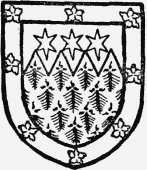
Estcourt. Ermine a chief indented gules with three six-pointed molets or therein, all in a border or charged with cinquefoils sable.
Robert Carey, earl of Monmouth, died at Moor Park in 1639 (fn. 128) and was succeeded by his son Henry, (fn. 129) who sold the park to Sir Richard Franklin in 1652. (fn. 130) Sir Richard bought the manor three years later and thus for a short time the manor and park were united. He sold the park in 1663 to James Butler, first duke of Ormonde, (fn. 131) who being a strenuous supporter of the house of Stuart, but poorly rewarded at the Restoration, was obliged to sell Moor Park in 1670 to James FitzRoy, duke of Monmouth. (fn. 132) Upon his execution in 1685 for his insurrection against James II, his estates were forfeited to the crown, but in 1686 Moor Park was restored to his widow, the duchess of Monmouth, (fn. 133) who sold it in 1720 to Benjamin Heskin Styles. (fn. 134) Mr. Styles died in 1739, and under his will Moor Park was sold in 1754 to Lord Anson, (fn. 135) who died in 1762 leaving his estates to his brother, Thomas Anson. In the following year Mr. Anson sold the estate to Sir Lawrence Dundas, bart., on whose death in 1781 it came to his son, Sir Thomas Dundas. (fn. 136) He sold it in 1785 to Thomas Bates Rous, who died in 1799 (fn. 137) without issue, leaving the estate to his widow. (fn. 138) In 1806 Arthur Edward Howman and Louisa Jane his wife, who may have been the widow of Mr. Rous, sold a third part of the manor of Moor to Robert Williams and William Williams. (fn. 139) Robert Williams died in 1814, (fn. 140) and was succeeded by his son Robert, (fn. 141) who in 1828 sold Moor Park to Robert, second earl of Grosvenor, (fn. 142) who was afterwards created marquis of Westminster. (fn. 143) On his death in 1845 Moor Park came to his third son Robert Grosvenor, created Lord Ebury in 1857, (fn. 144) and in his eldest son it is now vested.
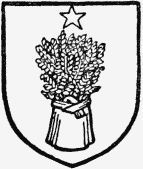
Grosvenor, Lord Ebury. Azure a sheaf or with the difference of a molet.
The site of the ancient house, marked by two moated inclosures, is about a third of a mile northeast of the present building, and on much lower ground. The site of the present building is nearly 300 ft. above sea level, and was, as it is said, first occupied by a house built by the duke of Monmouth in 1673, which must have been almost completely destroyed by Leoni in the second quarter of the eighteenth century, when he laid out the existing building for the successful South Sea speculator, Benjamin Styles. It faces north-east and south-west, the entrance being from the latter direction. Externally the elevations are pilastered; that on the northwest is developed into a tetrastyle portico, while the other, which is the garden front, has in place of the portico a central bay, treated with engaged columns, and carried slightly in advance of the main wall face. The details and proportions are of the most correct type, while the scale is monumental and handled with considerable skill. The material is Portland stone. There were originally two wings right and left of the entrance front and connected with the main block by colonnades, but these were pulled down by Mr. Rous, who acquired the place in 1785, to the great detriment of the composition.
In plan the house is as typical of its time as in design and decoration. The portico opens to a large hall of the ideal cubical proportion, on either side of which are smaller apartments, the grand staircase being on the left. Beyond the hall is the saloon, occupying the central bay of the garden front, and from it open two suites of smaller drawing-rooms which serve as ante-rooms to the grand dining-room on the left, and to the 'white drawing-room' on the right.
The hall is decorated with elaborate paintings by Amiconi representing the story of Io and Argus. The ceiling is painted to represent the lantern of a dome, and there is a gallery at the first-floor level. The five doorways have elaborate entablatures and are somewhat overloaded with colossal statuary all in white marble, while the floor is paved with large slabs of polished marble. The staircase and saloon are also decorated with paintings; in the case of the latter by Sir John Thornhill, under whose superintendence the decorations generally were carried out. The smaller drawing-rooms and the dining-room have some early examples of Chinese wall-papers, that in the dining-room being a remarkably fine one. The mantelpiece of the dining-room, of white marble, is a beautiful piece of work of late eighteenth-century date with two caryatides supporting the shelf and a frieze of exquisitely modelled dancing figures on a background of lapis lazuli. The white drawing-room is also most elaborate in its decorations, which in this case are purely plastic. The ceiling is decorated with mythological subjects in very high relief, and the walls are panelled with elaborately-worked enriched mouldings. On the north-east is the Italian garden, apparently in its present state the work of Launcelot Brown, who was employed during Lord Anson's ownership, and to whom are also largely due the socalled 'Old Pleasure Gardens,' some 200 yds. southeast of the house. The main entrance to the park is from Batchworth Heath, and there are also gates towards Watford and Rickmansworth, and near the latter, and separated from the park by the Watford road, is a charming garden of an informal type with a thatched cottage and summer-house said to be the work of the Adam brothers, of early nineteenth-century date and probably by a pupil. The artificial landscape gardening of 'Capability' Brown, referred to in his customary disparaging manner by Pope, (fn. 145) has left many traces to the present day, and the park is very well timbered and contains a herd of fallow deer.
Sir William Temple commends the garden as one of the best laid out in the kingdom. Mr. Styles cut a vista through the hill towards Watford, and another towards Uxbridge.
From a survey of the manor of Moor made in 1556, it appears that the lord of the manor had rights of fishing from le Newbridge to the west end of Croxley Hall, and the osiers in three islands called 'Eightes.' Mention is made of a tenement called the Tilehouse adjoining the south end of the parish church of Rickmansworth. There were two parks, the Great Park adjoining the Place containing 830 acres, wooded chiefly by hornbeam and maple, and the Little Park containing 208 acres, much overgrown with fern. The first of these the surveyors proposed to dispark and turn into arable. (fn. 146) The manor place was at that time much decayed. There were 415 deer in the Great Park and 90 in the Little Park. The house called Batchworth Heath Lodge was occupied by the earl of Bedford, the keeper of the park. (fn. 147)
The manor of CROXLEY (Crokesleya, xii cent.; Crokeslega, xiii cent.; Crokesle, xiv cent.) is stated to have been given to the monastery of St. Albans by Offa, king of Mercia. (fn. 148) Richard de Croxley was one of the knights of St. Albans in 1166, (fn. 149) and paid a fine for land in Hertfordshire ten years later, (fn. 150) and in 1210–12 Richard de Croxley and Philip de Oxhey held one knight's fee of the abbot of St. Albans. (fn. 151) Later in the thirteenth century the whole fee seems to have come into the hands of a member of the family of Croxley, whose Christian name is not known, (fn. 152) and who died leaving two sons, Richard and Roger. Richard died without heirs, and Roger left three daughters, Petronilla de Ameneville, Beatrice wife of John de Shelford, and Joan de Wauncy. (fn. 153) The manor of Croxley was conveyed by the numerous co-heirs of these three ladies to the abbot of St. Albans, (fn. 154) and in 1303 he was holding a quarter of a fee in Croxley without any sub-tenant, (fn. 155) and the manor does not seem to have been again subinfeudated at any subsequent time.
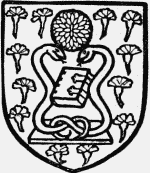
Caius. Or powdered with gilly flowers in the midst of the chief a houseleek resting on the heads of two serpents which support between them a book sable and are set upright with their tails knotted together on a square stone vert.
Abbot Richard in 1326 stayed at the manor-house of Croxley on his return from Rome, whither he went to obtain from the pope a confirmation of his election to the abbacy. (fn. 156) John son of William Aignel held rent from a tenement called Elyslond in the hamlet of Croxley in 1364, of the abbot of St. Albans. (fn. 157)
This manor formed part of the possessions of the abbey at the Dissolution, and was then held by William Baldwin under a lease for forty-four years, granted in 1538. (fn. 158) In 1556–7 the manor was granted to John Kaye or Caius, (fn. 159) one of the physicians of the royal household. In 1557 he refounded Gonville Hall where he had been educated, and to this college, which from that time became known as Gonville and Caius College, he granted the manor of Croxley. (fn. 160) From this time the manor has remained in the possession of the master and fellows of Caius College.
The existing manor-house was probably built about the end of the sixteenth century. The exterior has been much modernized and refaced with brick. Judging from the existing plan of the house, it would seem to have consisted of a central hall extending from front to back of the house. On the west side of the hall is an old panelled parlour, and on the east side is the front entrance with a narrow corridor, and a wing containing the kitchen offices. The building is of two stories.
At the west end of the house is a very massive old projecting chimney of brick. Through the lower part of this projecting brickwork is a deep arched opening with a window into the parlour. This window, pierced through the base of the chimney, appears to be an original feature, and is somewhat unusual. The bricks of this chimney are not more than 2¼ in. thick, and the joints are wide. These are the only old bricks visible in the building.
The parlour which adjoins the chimney is a room about 17 ft. square, and the walls from floor to ceiling are covered with oak panelling with moulded margins. A heavy beam, cased in panelling, runs along the ceiling, and is supported at the ends by solid curved struts. The existing fireplace is modern, but immediately above it the panels have arched heads, instead of being square as in the rest of the room. This evidently was intended to stand in the place of an overmantel to the old fireplace below. The door of this room has the quaint old forged double ornamental hinges of the period. None of the other rooms are panelled, but the old beams supporting the upper floor have roughly cut splayed edges with stops. The room, or old hall, adjoining the parlour has the remains of an ingle-nook, but the fireplace is modern.
The front door, which faces north, has a splayed oak frame, with a low four-centred arched head. A large baking oven projects outside, beside the fireplace in the kitchen, and, like many others in the district, has a tiled roof over it. All the chimneys, with the exception of the stack at the west end, are modern, that chimney being in fact almost the only external sign of antiquity about the building.
Close to the manor-house and forming part of the farm buildings is a very large and ancient tithe-barn which dates from pre-Reformation times. It measures internally 101 ft. long by 38 ft. 6 in. wide, and is divided on each side into five bays by cross walls about 10 ft. long, leaving a clear passage from end to end of the barn about 18 ft. 6 in. wide. These cross walls and the external walls, which are about 5 ft. in height from the floor, are built of flint with quoins and coping of Totternhoe stone, though in many places outside the walls have been patched with brick, and on the west side where the ground slopes steeply down from north to south, some buttresses of seventeenth-century brickwork have been built.
The timber of the roof appears to be of chestnut, though it is admittedly difficult to distinguish old chestnut from old oak, and both timbers are recorded to have been employed in mediaeval times.
In the centre of the east side is a lofty transept with wide folding doors, and the main roof on that side is carried down unbroken, so as to form low external sheds against the barn, thus giving an immense sweep of red tiled roof, and the picturesque appearance is enhanced by the natural slope of the ground, which is 15 ft. above the floor line at the north end of the barn, and 4 ft. below it at the south end.
The height inside from floor to ridge is about 35 ft. and the cubical contents of the barn exceed 100,000 cubic feet.
A messuage or a manor called CROSLEY (now called Parrot's Farm) was conveyed in 1541 by John Wingbourn to Ralph Morres, (fn. 161) and in 1562 Ralph Maurice and Henry Wingbourn and Elizabeth his wife sold it to Henry Mayne. (fn. 162) Henry died seised of it in 1605 leaving James his son and heir. The messuage was held at this time of the master and college of Gonville and Caius as of their manor of Croxley. (fn. 163) James died seised of the estate in 1642 leaving John his son and heir, (fn. 164) who died unmarried shortly afterwards, and was succeeded by his sisters, Mary, afterwards the wife of Thomas Engham, and Sarah, the wife of William Glascocke. Mary and her husband sold their moiety of the manor in 1656 to Daniel Parrett, (fn. 165) and in 1673 Sarah and William sold their share to Daniel son of the said Daniel Parrett. (fn. 166) From him the estate passed to his son Daniel, who bequeathed it to his son-in-law Jeremiah Smith, husband of his daughter Anne, who sold it in 1798 to Lord Clarendon. He sold it in the following year to Humphry Cornwall Woolrych, (fn. 167) who, dying in 1816, was succeeded by his only son Humphry William Woolrych, serjeant-at-law. He died in 1871 and the estate came to his third son William Richard, the present possessor. (fn. 168)
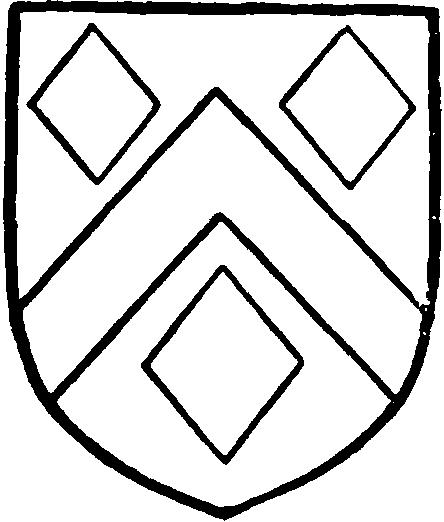
Hyde. Azure a cheveron between three lozenges or.
Parrot's Farm is part of the CROXLEY HOUSE estate which comprises about 265 acres. The house occupies the site of two older tenements known as 'Harry Smith's' and 'Harwards' or 'Harwells.' In 1620 William Sansome conveyed 'Harry Smith's' to trustees to the use of Mary, wife of Richard Tompson of Watford, who by her will, proved in 1653, gave it to her grandchild Mary wife of John Beckett. (fn. 169) It subsequently came to the Tuffens, descendants of Mary Tompson, and was conveyed in 1737 by Richard Tuffen to Solomon Andronin of Watford, who sold it in 1767 to Thomas, Lord Hyde, afterwards earl of Clarendon. (fn. 170) He built the present house in 1770 and it was sold in 1794 by his son Thomas, second earl of Clarendon, to Humphry Cornwall Woolrych. The house was considerably enlarged and the name changed to Croxley House, (fn. 171) which is now the residence of Mr. William Richard Woolrych.
CROXLEY GROVE
CROXLEY GROVE, on the edge of the green at the end of Baldwin's Lane, was built in 1834 by Miss Mary Bentley, great aunt of Mr. William Richard Woolrych, to whom it now belongs. (fn. 172) It is now the residence of Miss Dugdale.
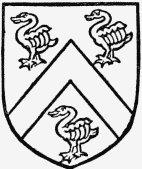
Woolrych. Azure a cheveron between three swans argent.
The manor of SNELLESHALL was acquired by Abbot Thomas (1349–96) of William, son of William Melman, for £80, (fn. 173) and it afterwards became annexed to the manor of Croxley, (fn. 174) and passed with it to the master and fellows of Caius College, to whom it now belongs. The site of the manor is lost.
Five manors (manenses) in PINCHFIELD (Pynesfield) were granted to the abbey of St. Albans by Egfrid son of Offa in 796. (fn. 175) William Pinefeld held land of the abbot of St. Albans in 1166. (fn. 176) Land in Pinchfield was acquired by Abbot Roger in the latter part of the thirteenth century of John de Britewelle, (fn. 177) and the manor was mortgaged by Abbot Hugh (1308–26) for sixteen years to Simon de Skote. (fn. 178) The manor remained among the possessions of the abbey until the suppression of the monastery, at which time it was leased to John Randulph for forty-one years. (fn. 179) It was apparently granted with the manor of Rickmansworth to the bishop of London, in 1550, for in 1591 John, bishop of London, surrendered it to Queen Elizabeth, (fn. 180) and by her it was leased for fifty years in 1591–2 to George Kirkham. (fn. 181) It afterwards descended with Rickmansworth (fn. 182) (q.v.) until 1806, when it was sold by Henry Fotherley Whitfield to the trustees of the will of Peter Isaac Thellusson. (fn. 183) It is now vested in his descendant, Mr. Charles Thellusson, of Brodsworth Hall, Doncaster.
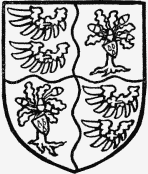
Thellusson. Quarterly wavy argent and or, in the first and fourth quarters two wings set fessewise sable each having a golden trefoil upon it and in the second and third quarters an oak tree torn up by the roots having a scutcheon gules with three drops argent hanging from the branches.
The manor of BIGGING was granted by Edward de Montibus, son and heir of Eubold de Montibus, to his wife, Margaret Pippard, for her life, probably about the middle of the fourteenth century. (fn. 184) Edward's eldest son alienated the manor by fine to Thomas Cheyne, who died without issue. (fn. 185) Margaret, however, survived him for a long time, and on her death, at the beginning of the fifteenth century, the abbot took possession of the manor, probably owing to lack of an heir. (fn. 186)
In 1392–3 it was held by Henry de Chilterne when a valuation of his lands was taken for debt. (fn. 187) In 1535 John and George Wyngborn, sons of George Wyngborn and Emma his wife, then wife of George Herd, conveyed the manors of Bigging and Fordes to Robert Curson, William Andrew and Robert Andrew. (fn. 188) The manors were held by Emma and George Herd for the life of Emma. (fn. 189) All trace of this manor has long since been lost, and not even the name of Bigging survives at Rickmansworth.
The manor of BATCHWORTH (Becceswurtha, xi cent.; Bachesworth, xiv cent.; Baccheworthe, xv cent.) is said to have been granted to the church of St. Albans by Offa, (fn. 190) and was afterwards held of the abbey by the service of a quarter of a knight's fee, and suit at the hundred of Cashio. (fn. 191) In 1238–9 Geoffrey Est conveyed a virgate and a half of land in Batchworth to Richard Blaket, (fn. 192) and in 1328 Thomas, son of William Blaket, obtained a grant of free warren in his demesnes of Rickmansworth. (fn. 193) In 1456 a messuage and four cottages in Rickmansworth, which formerly belonged to Thomas Blaket, were held by Ralph le Boteler, lord of Sudeley, of the abbot of St. Albans. (fn. 194) The Blakets do not appear, however, to have held the manor of Batchworth, for in 1289–90 Philip Burnel conveyed it to John de Wanton and Margaret his wife. (fn. 195) Agnes daughter of Hugh de Bachesworth in 1221 claimed two messuages and half a virgate of land in Batchworth, which were held by her uncle Bartholomew the goldsmith. The jurors, however, said that Hugh had never been seised of the tenement, and that Agnes had no claim in it. (fn. 196) The manor was held in 1301 by Richard de Bachesworth to whom it had been granted about 1294 by his brother Roger. (fn. 197) Roger de Bachesworth was holding land in 1244 and 1257 by knight service of the abbey of St. Albans, (fn. 198) and in 1258 Geoffrey de Bachesworth presented a piece of silken cloth to the abbey. (fn. 199) Isabel the wife of Roger de Oxford recovered seisin of the manor in 1307–8 against John de Bachesworth, Margaret daughter of Richard de Bachesworth, Elizabeth, Joan, and Oraseth, sisters of Margaret and others. Margaret claimed this manor jointly with her sisters as heirs of their father Richard, who had held the manor by gift of his father, Richard de Bachesworth. (fn. 200) Isabel, wife of Roger de Oxford, claimed and recovered the manor against the four sisters, (fn. 201) and in 1309–10 she conveyed the manor to Roger de Frowyk, called 'le orfeure' or the goldsmith, and Idonea his wife, and John their son. (fn. 202) Richard de Bachesworth put in a claim, but in 1311–12 he renounced it to Roger and Idonea. (fn. 203) To this conveyance John son of John de Dene and Margaret his wife, and Elizabeth sister of Margaret, probably the daughters of Richard de Bachesworth mentioned above, opposed their claim, (fn. 204) but the question seems to have been settled in favour of Roger de Frowyk, who in 1314–15 granted the manor to his son John and Isabel his wife. (fn. 205) It would seem that Isabel, or perhaps one of her daughters, married Robert de Ashele, for in 1324–5 the reversion after the death of Isabel, wife of Robert de Ashele, was granted to John de Latimer and his heirs by John Merlyn. (fn. 206)
John de Latimer in 1331–2 granted the manor to John de Swanlond, parson of the church of Middleton. (fn. 207) This conveyance was made for the purpose of a settlement on the children of Simon de Swanlond, i.e. Simon, William, John, Matilda, Elizabeth, and Katherine in fee tail. (fn. 208) In 1385–6 William Swanlond was lord of the manor, (fn. 209) and from him it came to William Hampton. (fn. 210) In 1415–16 Richard Selley, John Phelip, Richard Hampton, and others held this manor for the life of William Hampton and Joan his wife of the inheritance of John Cristemasse, who granted the reversion to Edmund Brudenell and Alice his wife, (fn. 211) and in the following year William Shrewsbury, clerk, and John Bentley granted the manor to William Flete. (fn. 212) William held the manor in 1431 of the abbot of St. Albans for a third part of a knight's fee, and aid, and suit at the court of the hundred of Cashio every three weeks. (fn. 213) In 1435–6 Robert son of Henry Brudenell released to Thomas Wandesford, William Flete, and others all his rights in the manor of Batchworth. (fn. 214) The manor afterwards passed to Sir Ralph Boteler, lord of Sudeley, (fn. 215) probably in the same way as the manor of Moor, (fn. 216) with which it has passed to Lord Ebury.
In the reign of Henry VIII Thomas Ayleward died seised of a capital messuage called Batchworth Hall, which descended to his daughter Agnes, wife of John Algood of Langley Mareis. (fn. 217) In 1520 John Heed surrendered into the hands of the lord of the manor of Moor the site of the manor of Hampton Hall, or Batchworth Hall, lately in tenure of John Ayleward and Helen his wife. The said site was then granted to John Heed and Joan his wife. (fn. 218) In 1684 Gideon Awnsham sold to Jermingham Chaplin the capital messuage called Hampton Hall for a term of 500 years as a security for the payment of a certain sum of money to Jermingham. Gideon, by his will, devised the estate to his wife Margaret Awnsham for life, with remainder to his right heirs. After Gideon's death Margaret purchased the reversion in 1685 from Nicholas Awnsham, cousin and heir of Gideon, and in 1694 Jermingham sold his interest in the manor for the rest of the term of 500 years to Thomas Day of Bray. Margaret sold the estate in 1700 to Henry Warren and his heirs, and in 1705–6 Richard Phrip purchased the estate from Henry Warren, and the interest for the remainder of the term from Thomas Day, thereby becoming the absolute possessor of the estate. (fn. 219)
Hampton Hall, the old manor-house, has long since fallen into decay, but the walls still stand. The site is at the foot of the hill on which is Moor Park.
The manor of ASHLEYS (Ashele), consisting of a messuage, 1 carucate of land, 14 acres of meadow, 10 acres of pasture, and 5 acres of wood, together with a virgate of land called Hawkwelleslond, and 4s. of rent was held by John son of William Aignel, who died in 1364 leaving a son John aged three years. In the inquisition taken on the death of John the manor was said to be held of the heirs of Stephen atte Grove in free socage for a service of 4d., and was worth by the year £4. (fn. 220) This estate with others in Rickmansworth was burdened with a rent of £20 per annum for the life of John de Chilterne, father-inlaw of John Aignel, by grant of the said John. (fn. 221) The finding of this inquisition was disputed by the abbot of St. Albans, who claimed that John held the manor of him by knight service, (fn. 222) and he also denied that it was burdened with any rent to John de Chilterne, (fn. 223) whom he accused of intruding on the possession of the abbot. The finding of the jury was in favour of the abbot, and seisin of the manor with the custody of the heir was delivered to him in 1366. (fn. 224) In 1416 Katherine wife of John Curteys, formerly wife of John Aignel, and John Impey and Joan his wife, kinswoman and heir of John Aignel, conveyed their respective rights in the manor to William Flete and others. (fn. 225) In 1431 a dispute arose between the abbot and William Flete as to the tenure of this manor. William, quoting the inquisition on the death of John Aignel, claimed to hold it of the heir of Stephen atte Grove, who had granted the manor by fine to Robert de Ashele, it having been previously held by William de Ashele. William Flete now claimed the status of Robert in the manor. The abbot acknowledged that there had been such a fine, but that the said heir of Stephen atte Grove had held the manor of the abbot, so that the effect of the fine was to make Robert the immediate tenant of the abbot. The jury again in this case upheld the right of the abbot.
The site of the manor of Ashele was in the hamlet of Batchworth, and it was parcel of Danielshide, which in turn was parcel of the abbot's manor of Rickmansworth. The abbot had been seised of services for this manor from time immemorial, and it was held for a twenty-first part of a knight's fee. (fn. 226) From this point the descent of the manor is identical with that of Moor, in which it appears to have become merged after the Dissolution. All trace of the manor of Ashleys has now disappeared.
The manor of BRITWELL (Brittewell, Brutewell) was held of the abbot of St. Albans by the service of suit of court, (fn. 227) and was said to have been granted to the abbey by Offa. (fn. 228) In the early part of the thirteenth century Alice de Bretwelle held one hide in Rickmansworth, (fn. 229) and in 1225 land in Britwell was held by Peter de Bretwelle, against whom it was claimed by John de Wittenham and Alice his wife and Richard Grimbald and Martina his wife. (fn. 230) Land in Britwell, formerly held by William son of John de Shelforde, was held in the thirteenth century by John de Britwell, and the abbot commuted his service from suit of court to knight service in the king's army. (fn. 231) In 1301–2 this land had come to coheirs whose names are not given, (fn. 232) and in 1303 Thomas de Wymundesham held a sixth part of a knight's fee of the abbot of St. Albans in Britwell. (fn. 233) John de Watford held this fee in 1320–1, (fn. 234) and in 1364 the manor under the name of a tenement called 'Brutewelles' was in the hands of John de Chilterne, (fn. 235) who conveyed it in this year to Ralph de Harpele, rector of 'Scheringe,' and Ralph Megre, chaplain. (fn. 236) These grantees conveyed it in 1366 to Richard son of Richard de Hemington and John son of John de Radeswell, sons of Margery and Margaret, daughters of John de Chilterne. The manor was to be held by Richard and John for their lives with remainder in tail male to Henry and Pain, sons of John de Chilterne, and to Andrew de Bures, Richard de Hemington, John de Radeswelle, and John Aignel, grandchildren of John de Chilterne. (fn. 237) Henry de Chilterne granted this manor in 1371–2 to Edmund de Gessinge and Katherine his wife and their heirs and assigns for ever. (fn. 238) In 1381 Philip Bluet and Katherine his wife, who was the daughter of John de Chilterne, conveyed the manor to John de Raddeswelle and Richard de Hemington, (fn. 239) and this conveyance was confirmed by Henry and Pain de Chilterne, brothers of Katherine. (fn. 240) Richard and John then reconveyed it to Philip and Katherine to be held by them for their lives for a rent of six marks to John and Richard, with reversion after the death of Philip and Katherine to John and Richard, and their heirs. (fn. 241) In 1410–11, this same Katherine who was then the wife of John Gloucester and her son Andrew Bures conveyed the manor to Henry, bishop of Winchester, William Flete and others, and this grant was confirmed by Pain de Chilterne. (fn. 242) They in return granted Katherine a rent of 100s. from the manor. (fn. 243) In 1414 Katherine, the wife of William Creke or Creyke, daughter of Henry de Chilterne and Eleanor his wife, (fn. 244) granted the manor to William Flete and John Deryng, two of the grantees mentioned above, probably in confirmation of the grant of Katherine her aunt, as heiress of her father Henry. (fn. 245)
William Flete in 1431 claimed to hold this manor partly of Robert de Louthe at a rent, and partly as of the manor of Moor, which William himself held at that time. The manor had once belonged to Thomas Wymundham and afterwards to John Watford, clerk. (fn. 246) The abbot, however, said that William Flete bought the manor, and that it was held of the abbot for homage and fealty and rent, and it was decided in the courts of law that the abbot was justified in his claim. (fn. 247) From this time the manor of Britwell descended with the manor of Moor (q.v.), and its site is now marked by Brightwells Farm in Watford parish, near to Hamper Mills. This farm was held in 1556 by copy of court roll of the manor of Moor, by Thomas and William Wedon. (fn. 248)
The manor of MICKLEFIFLD or MICKLEFIELD HALL (Mekelfeld) is said to have been granted to St. Albans by Offa. (fn. 249) Land in the vill of Micklefield was obtained: or the abbey of St. Albans under Abbot Roger (1260–90) from John de la Grave and Petronilla his wife. (fn. 250) In 1308 Thomas de Mickelfield died seised of the manor which he held of the abbot of St. Albans. (fn. 251) John de Chilterne in 1364–6 settled this manor on his grandsons Richard de Hemington and John de Radeswelle, with remainder to Henry and Pain, sons of John de Chilterne, and others in tail male. (fn. 252) In 1392–3 it was in the possession of Henry de Chilterne, (fn. 253) from whom it descended to his daughter Katherine, wife of William Creke. (fn. 254) Pain de Chilterne claimed the manor against William and Katherine in 1419–20, (fn. 255) but the entail mentioned above seems to have been barred by a settlement on the marriage of William Creke and Katherine. (fn. 256) William Creke, probably son of William and Katherine, was succeeded in 1475 by his son Thomas, (fn. 257) who with John Creke conveyed the manor in 1518–19 to Sir Robert Brudenell and others. (fn. 258) This conveyance was probably made for the purposes of a settlement, for the manor descended from Thomas to his son William, and from him to his son John. (fn. 259) John left three sons, William, Stephen, and Bonaventure, who were minors at the time of their father's death. The abbot of St. Albans claimed the custody, as the manor was held of him as of the manor of Croxley by knight service. Joan, widow of John, disputed his claim, saying the manor was held by socage tenure, and in 1537 an agreement was made whereby the abbot gave up his claim to the custody. (fn. 260) It would seem that Joan had good reason for wishing to retain the custody of her sons in her own hands, for in a letter written to Cromwell, asking his help, she stated that 'four score years ago the then abbot of St. Albans had, wrongfully, my husband's grandfather to his ward. When he was fourteen years old the abbot sold him to a fishmonger of London, who kept him two years. The child then ran away from the fishmonger to a knight, Sir Davy Philip, who married him to Mr. St. John's daughter, of Kent. The friends of the wife sued the abbot, and proved that he was not his ward, when the abbot gave him, in recompense for the injury, a farm called Ballards beside Luton, and when the young man was dissatisfied, the abbot made him master of his game.' (fn. 261)
In 1551 the manor was settled on Joan and her second husband Thomas Bright for their lives, with remainder to Stephen Creke son of Joan, (fn. 262) and in 1555 the manor was held by Thomas Bright freely by fealty and suit at court. (fn. 263) In 1573 Stephen Creke and Olave his wife conveyed the manor to William Revett or Ryvett, (fn. 264) and in 1591 Thomas Ryvett and Anne his wife sold it to John Robinson. (fn. 265) Sir John Robinson in 1700 conveyed it to John Merrick, (fn. 266) whose son John sold it in 1712 to John Putnam. (fn. 267) John sold the manor, with the pew in the parish church of Rickmansworth belonging to it, to William Emmott in 1717, (fn. 268) and he and his wife conveyed it three years afterwards to Thomas Houghton. (fn. 269) This conveyance was, however, made for a settlement, for William Emmott devised the manor by will dated 10 June, 1735, to his only son and heir Thomas, who by his will dated 13 January, 1774, gave it to his daughter Elizabeth wife of Joseph Skidmore, with remainder to his grandson Emmott son of Joseph and Elizabeth. (fn. 270) On the death of Emmott in 1836 the estate came to his son Thomas Emmott Skidmore, who sold it in 1844 to Thomas Clutterbuck. (fn. 271) It now belongs to Mr. Thomas Meadows Clutterbuck.
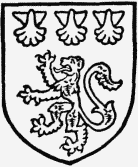
Clutterbuck. Azure a lion ermine and in the chief three scallops or.
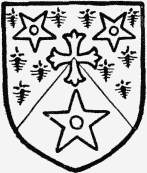
Day. Party cheveronwise erminois and sable with two pierced molets sable in the chief and a like molet or in the foot and between them a cross paty parted cheveronwise sable and or.
The MICKLEFIELD GREEN ESTATE adjoins Micklefield Hall, and was at one time in the possession of the family of Creke, lords of the manor of Micklefield. In 1515 William, son and heir apparent of Thomas Creke, conveyed it probably for the purposes of a trust to John Newdegate and others. (fn. 272) In 1556 Stephen Creke sold the estate to Ralph Day of Abbots Langley, in whose family it remained till 1750, when it was sold by Ralph Day to John Merry. (fn. 273) Sixty years later Thomas son of Ralph bought it back, and dying in 1827 left it to his grandson Thomas Day Branton, on condition that he assumed the name of Day. Thomas Branton Day died in 1862 and was succeeded by his eldest son Ralph Branton Day, (fn. 274) who held in 1880. It has descended in the family of Day, and the present tenant is Mr. Forbes Woodhouse. Micklefield Green is wholly in the parish of Rickmansworth, but adjoining lands have been purchased from time to time, so that the estate now extends into the parishes of Sarratt and Watford.
The manor of NEWHALL forms part of this estate. An account of it will be found under the parish of Watford.
The manor of LANGLEYS or LINSTERS. In an undated Chancery suit Thomas Congreve and Elizabeth his wife, formerly the wife of Roger Lynster, claimed this manor against John Clyfton and Richard Dunton. (fn. 275) At about the same time Elizabeth fell out with Henry Lynster as to her title in this manor. It seems that she was to dwell in the manor-house until a certain date, and when the time came for her to leave she refused to do so. (fn. 276) The manor consisted of one messuage and a carucate and a half of land, and it was held by William Heynes and William Beaufitz in 1460, and had previously been held by Roger Lynster. It was held at this time of the abbot and convent of St. Albans for a rent of 9s. 11d. which had been granted in 1456 to Sir Ralph Boteler, lord of Sudeley. (fn. 277) In 1520–1 the master of the Savoy held land called Langleys and Congrevys, lately of Ralph Bukberd, of the lord of the manor of Moor. (fn. 278) When the lands of the Savoy came to the crown this manor was granted in 1553 to the governors of St. Thomas's Hospital, by the title of the manor of Linsters or Langleys, (fn. 279) and they are the present lords. The estate now consists of one farm north of West Hyde.
The manor of WOODWICKS (Woodoakes) was held of the abbot of St. Albans by knight service. (fn. 280) Richard de Wodwick was holding a hide in Hertfordshire of the abbey of St. Albans in 1210–12, (fn. 281) and a tenant of the same name held it in 1257. (fn. 282) Richard must have died at about this time, as in 1258 the hide had passed to William de Wodwick. (fn. 283) In 1303 John de Wodwick held a seventh part of a knight's fee in Rickmansworth of the abbot, (fn. 284) and in 1347–8 this fee had passed to William de Wodwick, (fn. 285) and was held by his heirs in 1428. (fn. 286) The manor of Woodwicks was held in 1570 by Robert Colte, who with his son Roger conveyed it to Richard Peyton and Thomas Shadbolt, (fn. 287) probably trustees for a settlement. Roger succeeded his father and settled it in 1570–1 upon his wife Mary, only daughter of George Basford. (fn. 288) Roger died seised of the manor in 1575, leaving a son John, one year old. (fn. 289) John settled the manor in 1596 on his wife Frances, (fn. 290) and died seised of it in 1610, (fn. 291) leaving his son and heir John a minor. This John was afterwards knighted, and married Anne, daughter of Albericus Gentilis, (fn. 292) an eminent writer on civil and international law. Their daughter Gentilis married Sir Benjamin Tichborne, who was lord of the manor in 1700. (fn. 293) Sir Benjamin was succeeded by his son Colte Tichborne, (fn. 294) and from Colte the manor passed to Frances Tichborne and afterwards to James Patten. (fn. 295) From him it came to John Sedgwick and afterwards to William Sedgwick, but these last two seem to have held it only under a lease for twenty-one years. (fn. 296) The manor was bought in 1816 from Samuel Leightenhouse and Hannah his wife by Robert and William Williams, (fn. 297) and they in 1827 sold it to the Thellusson trustees. (fn. 298) The estate, which has now lost all manorial rights, belongs to Lord Rendlesham. The site of the manor still remains at Woodoaks Farm in Maple Cross. Near this Farm at Warren Hill is a remarkable echo which will repeat twelve times to a trumpet.
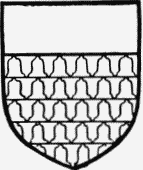
Tichborne. Vira a chief or.
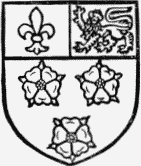
King's College, Cambridge. Sable three roses argent with a chief azure a fleur-de-lis or parted with gules a leopard or.
In 1314 Oliver de Burdegal [Bordeaux ?], the king's secretary, granted to the abbey of St. Albans land called LA TROY, now TROY FARM, 'near the manor of Sarratt,' with the land and tenements of Geoffrey, Turkild, and Alexander le Fool, and their bodies and 'sequela.' These possessions had been granted to Oliver by the king. (fn. 299) This grant was confirmed by Edward III in 1338. (fn. 300)
Troy farm is now in the ecclesiastical parish of West Hyde, and belongs to the master and scholars of King's College, Cambridge.
No mention of the manor of the RECTORY of RICKMANSWORTH is found before the Dissolution. After that time it was held by the bishops of London (fn. 301) until 1650, when it was sold by Act of Parliament to William Newbold and Henry Flatman. (fn. 302) At the Restoration the manor was restored to the bishop, and it is now vested in the Ecclesiastical Commissioners. The parsonage house and farm belong to Mr. John Saunders Gilliat, who bought them about 1870. The manor-house is a fine old farm-house of brick and rough-cast, containing some large rough-hewn beams, and there is a picturesque old barn near, a favourite study for artists.
CHURCH
The church of OUR LADY is not of much architectural interest, no part of the present building being older than the seventeenth century. It consists of a chancel with north chapel and south vestry and organ chamber, nave with aisles, and west tower. The tower is dated 1630, and is a good specimen of the Gothic work of the time, built of flint and stone in three stages with clasping buttresses, and finished with an embattled parapet and short leaded spirelet. The belfry windows are of three lights with uncusped tracery, and those in the second stage of two trefoiled lights under square heads, while the west window of the ground stage, above which is the stone giving the date of the tower, has wooden tracery. Below is a plain west doorway of a more modern date. The aisle walls are of red brick with four-centred windowheads and wooden mullions, poor, mean-looking work of early nineteenth-century date, and until lately the body of the church was entirely in this style. It has now, with this exception, been rebuilt in flint and stone in fifteenth-century style, the chancel having an east window of five lights, and the nave north and south arcades of five bays with three-light clearstory windows. The woodwork of the church is all modern, and the font, at the south-west of the nave, appears to be of the seventeenth century. At the east end of the north aisle is a brass to the memory of Thomas Day, 1613, and his two wives, and on the north side of the chancel is the raised tomb of Henry earl of Monmouth, 1661, with an alabaster panel bearing his arms with supporters at the west end.
The materials of the altar-table, a slab of black marble carried on two white marble columns, once formed part of this tomb.
The glass in the east window was brought here from the church of St. John at Rouen, and is of midsixteenth-century date.
There are eight bells and a priest's bell; all the eight are by Lester & Pack of London, 1765. There were five bells in 1552, which are traditionally said to have been very heavy, and to have been cast into the present eight in 1765. (fn. 303)
A plan of the church dated 1825, and showing its arrangements before the rebuilding of c. 1850, is given in Cussans's History of Hertfordshire.
The plate is a fine and interesting set, comprising a good communion cup and cover paten of 1559; a second cup and paten made to match the first in 1628; a large silver-gilt cup and paten, c. 1600, bearing no marks except that of the maker, v s; a silver-gilt flagon of 1695; and a gadrooned silver salver of 1692, given by Lady Ann Franklin in 1694. This last has apparently been refashioned from a piece of slightly earlier date, c. 1670, and on it is to be seen a partly defaced shield with feather mantling and an impaled coat, the dexter side of which has a pheon in base, and the sinister a cheveron and a cross paty, the upper charges being obliterated.
The first book of the registers contains baptisms and burials from 1653 to 1716, and marriages from 1653 to 1704; the second book, baptisms and burials from 1704 to 1722, and marriages from 1716 to 1722; the third book contains baptisms and burials from 1723 to 1766 and marriages from 1723 to 1753; the fourth book, baptisms and burials from 1766 to 1797; the fifth, baptisms and burials from 1797 to 1812; the sixth, marriages from 1754 to 1798; and the seventh, marriages from 1798 to 1812. There are Bishop's Transcripts for 1570, 1581, 1590, 1592, 1593, 1596, 1598, 1599, and 1629. (fn. 304) The first book contains, in addition to the ordinary entries, a list of persons touched for the king's evil by Charles II.
ADVOWSON
The church of Rickmansworth belonged to the abbey of St. Albans, and was confirmed to them by Pope Honorius III in 1219. (fn. 305) It was granted by Abbot Geoffrey to the sacrist of St. Albans. (fn. 306) At the time of the Dissolution Henry Gunner was farmer of the rectory. (fn. 307) In 1550 the rectory and advowson of the vicarage were granted to Nicholas Ridley bishop of London, (fn. 308) and in 1553–4, when Bishop Bonner was reinstated, the advowson of Rickmansworth church was granted to him by Queen Mary. (fn. 309) It remained vested in the bishops of London till 1852, when it was transferred to the bishops of Rochester, with a reservation that the bishop of London should present to the next vacancy either of Fairsted, Kelvedon, Southweald, Thorley, or Rickmansworth, as he should select. (fn. 310) In 1877, on the foundation of the bishopric of St. Albans, the patronage was transferred to that see.
It appears to have been leased at various times, for Roger Hutchinson, in his will proved in 1555, mentions a lease of the advowson of Rickmansworth, (fn. 311) and in 1570–1 it belonged to Roger Colte, the owner of Woodwicks. (fn. 312)
During the time when Cardinal Wolsey was at Rickmansworth, some of the inhabitants showed their Protestant tendency by destroying the chancel, vestry, organ, and rood-loft by fire. They also broke open the font, which was kept locked to prevent the holy water being used for improper purposes, and scattered the water on the pavement. The cardinal issued an indulgence of a hundred days, to which the bishop of the diocese added forty more for all who would contribute to the rebuilding of the church. (fn. 313) Further damage was done in the church in 1640, when Edmund Aylee and others 'did come into the church of Rickmansworth, and after sermon and service ended in the forenoon did there wittingly and suddenly pull down and break in pieces the rayle about the Communion table, and also in the afternoon of the same day did also wittingly and suddenly break down and deface a part of the cover of the font.' (fn. 314)
There is a church dedicated in honour of All Saints at Croxley Green, erected by the subscriptions of the parishioners, and opened in 1872. (fn. 315) The living is in the gift of the vicar of Rickmansworth, and the vicarage house was built in 1876.
Christ Church, a chapel-of-ease, was built at Chorleywood in 1845, and rebuilt in 1870. (fn. 316) The living was originally a perpetual curacy, but became a vicarage in 1868. (fn. 317) The right of presentation was vested in James Hayward, who sold it in 1868 to John S. Gilliat. (fn. 318) Later on, in order to obtain an increase in the endowment from the Ecclesiastical Commissioners, it was vested in five trustees. (fn. 319) The vicarage house was presented to the parishioners by John S. Gilliat.
There is a church dedicated in honour of St. Peter at Mill End, erected in 1875. The living is a vicarage in the gift of the vicar of Rickmansworth. At Herringsgate there is a chapel-of-ease to the church at Mill End, dedicated in honour of St. John the Evangelist. The church of St. Thomas, West Hyde, was built in 1845. The living is a vicarage in the gift of the bishop of St. Albans. There is also a mission hall at West Hyde, erected in 1889.
There was a church-house at Rickmansworth in the fifteenth and sixteenth centuries, which had belonged before the Dissolution to the inhabitants of the town. It was granted in 1588–9 to William Tipper and Robert Dawe. (fn. 320)
The vicarage, which stands on the west side of Church Street, at a short distance to the north-west of the church, is in part a mediaeval building, originally consisting of a hall and two wings, and has on the north front some moulded brickwork, probably of early sixteenth-century date, with trefoiled panels. The house was originally of timber construction on a brick base, but has been added to at various times, and the result, though very picturesque, gives little clue to its ancient arrangements.
There was a chapel of the B. V. Mary in the churchyard of Rickmansworth in the fifteenth century, also called the chapel of St. Mary 'de Insula,' (fn. 321) and 'our Lady of Ilond,' and another chapel of St. Katherine. (fn. 322) Fraternities of the Holy Trinity, St. Katherine the Virgin and Martyr, and of le Charnell House also existed in the fifteenth and sixteenth centuries, (fn. 323) but seem to have disappeared before the Dissolution. There was an altar of St. Edmund, and lights of Trinity, Holy Cross, St. Mary, St. Edmund, St. Katherine, and many others were maintained in Rickmansworth church. (fn. 324)
Rickmansworth has long been a stronghold of Nonconformity. Thomas Hemmingforth, the vicar in 1480, was ejected five years later for apostasy, which probably meant Lollardism. Several inhabitants of Rickmansworth were among the persecuted Lollards who, in 1511, had their head quarters at Amersham. Owing to William Penn's residence at Rickmansworth this parish became an important centre of Quakerism. The Quakers who did not accompany him to America used to meet at a house in Chorleywood, and the garden belonging to it was used as a cemetery by the society. Miss Groom's house is now on the site of this cemetery. There is a notice of a conventicle held at Rickmansworth in 1669, and many houses were registered by Presbyterians, Baptists, Independents, and Protestant Dissenters. The Independents opened a chapel at Mile or Mill End in 1798, and a Congregational chapel was built in 1811. (fn. 325) An Ebenezer chapel for Baptists was opened in 1825, and Baptist and Wesleyan Methodist chapels were registered for marriages in 1865. (fn. 326) There is a Primitive Methodist chapel at Chorleywood, and another in New Road, in Croxley Green, which was built in 1893 upon the site of an earlier one erected in 1868. The Wesleyan chapel at Herringsgate was built in 1884. The Roman Catholic chapel in High Street, opened in 1891 and enlarged in 1898, is dedicated in honour of our Lady of Help of Christians, and is served from Boxmoor.
CHARITIES
Charity School Fund.
—A school for the poor of this parish was founded in or about 1711, to which, in 1729, Mrs. Osborne by her will left £50, Mrs. Frances Tichborne also bequeathed £50, and in 1763 Mrs. Sarah Holme gave £100, which several sums were invested in South Sea annuities. Sir Thomas Franklin by his will dated in or about 1729 gave to the use of the Charity School a rent-charge of £4, free of all taxes, issuing out of a close containing 4 acres, called 'Andrews,' at Ascot in the parish of Ruislip, so long as the school continued, and in the event of its discontinuance, to be applied for the benefit of the poor.
In 1814 a piece of ground was purchased and a new school erected thereon with the legacies above mentioned and with accumulations of income.
By an order of the Charity Commissioners, dated 22 December, 1899, the trustees were authorized to sell the site and old schoolhouse for £1,000, and thereout to expend £400, increased to £800 by an order of the Board of Education of 9 June, 1902, towards defraying the cost of enlargement of the girls' and infant school founded in 1854.
The proceeds of sale were invested in consols with the official trustees, and a balance of £105 19s. 2d. consols remains in their corporate name.
By an order of the Board of Education of 27 July, 1903, trustees of the Charity School Fund were appointed, and a scheme established authorizing the dividends to be applied (a) in payment of not less than 10s. or more than £1 each in the nature of exhibitions to children resident in the ancient parish of Rickmansworth attending public elementary schools; (b) in providing in such schools apparatus suitable for object lessons.
The Manor Almshouses alias the Fotherley Almshouses.
—In 1701 John Fotherley by deed conveyed to trustees five cottages or almshouses which he had then lately built, and endowed the same with an annuity of £10 issuing out of certain estates in this parish (including the market-house), free of all deductions upon trust to permit five poor widows of the parish to inhabit therein.
The property charged became the properties of several owners, and by agreement the sum of £5 was charged on the market-house, and £5 on Rickmansworth Park. The inmates are also entitled to receive on 16 January in each year the dividends of £100 7s. 6d. consols, called 'Howard's gift,' bequeathed in 1889 by will of Elizabeth Harman, subject to an existing life interest.
The Parish Almshouses were founded by will of John Beresford, who devised two messuages at the town's end upon trust to permit four aged poor people of the parish to inhabit therein.
In 1681 William Ford by his will left £100 to be laid out in land, the rents to be applied for the benefit of the poor; a close in the parish containing about 13 acres, called 'Hutchinworth,' was purchased therewith. The close was sold in or about 1880, and the proceeds invested with the official trustees, who now (1906) hold £1,294 19s. 5d. consols in trust for this charity. In 1708 Lady Ann Franklin by her will directed that a yearly sum of £10, free of taxes, issuing out of the Moor Park estate, should be distributed amongst the poor. This is now included in the official scheme for the maintenance of the above almshouses.
In 1883 Mrs. Mary Fellows by her will directed that the dividends on £55 18s. 2d. reduced 3 per cents. (now consols) should be annually paid to the six poor women, occupants of the six parish almshouses at Christmas in equal shares, and the testatrix further directed that the dividends on £55 18s. 2d. stock (now consols) should be paid to the inmates of the almshouses in equal shares.
In 1894 a scheme was established by the Charity Commissioners authorizing the sale of the old almshouses, which had become unfit for habitation, for £400, and the expenditure of £600 in building new almshouses on a site gratuitously conveyed by Lord Ebury, and providing that these charities should form part of the endowments of the parish almshouses.
